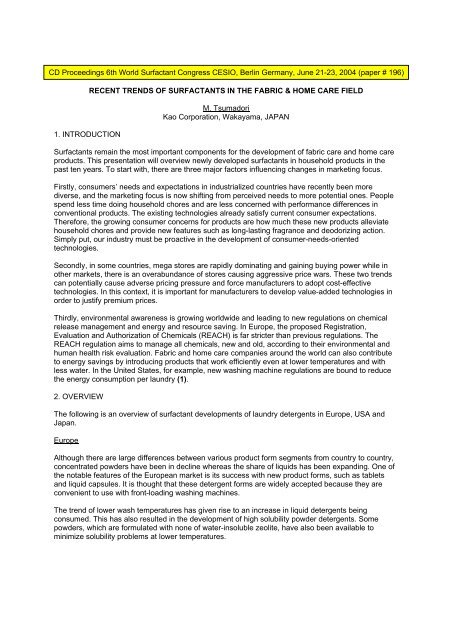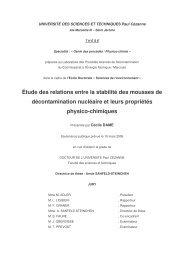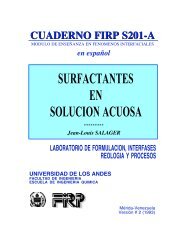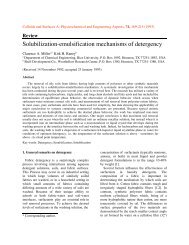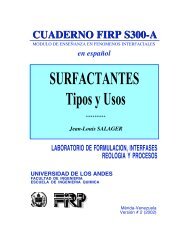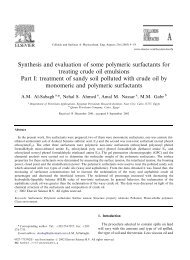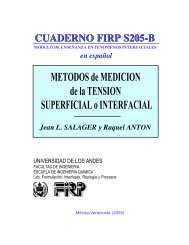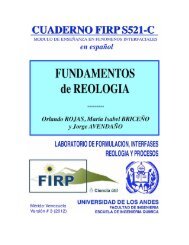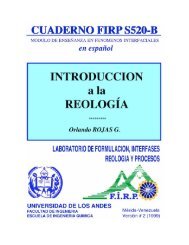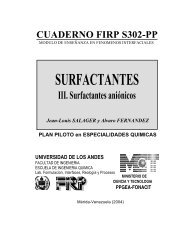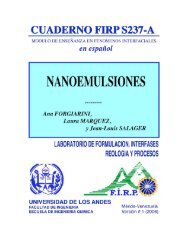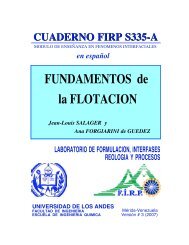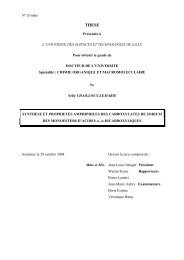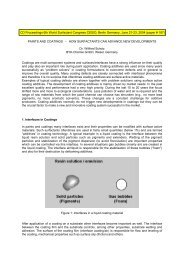Recent Trends Of Surfactants In The Fabric
Recent Trends Of Surfactants In The Fabric
Recent Trends Of Surfactants In The Fabric
Create successful ePaper yourself
Turn your PDF publications into a flip-book with our unique Google optimized e-Paper software.
1. INTRODUCTION<br />
RECENT TRENDS OF SURFACTANTS IN THE FABRIC & HOME CARE FIELD<br />
M. Tsumadori<br />
Kao Corporation, Wakayama, JAPAN<br />
<strong>Surfactants</strong> remain the most important components for the development of fabric care and home care<br />
products. This presentation will overview newly developed surfactants in household products in the<br />
past ten years. To start with, there are three major factors influencing changes in marketing focus.<br />
Firstly, consumers’ needs and expectations in industrialized countries have recently been more<br />
diverse, and the marketing focus is now shifting from perceived needs to more potential ones. People<br />
spend less time doing household chores and are less concerned with performance differences in<br />
conventional products. <strong>The</strong> existing technologies already satisfy current consumer expectations.<br />
<strong>The</strong>refore, the growing consumer concerns for products are how much these new products alleviate<br />
household chores and provide new features such as long-lasting fragrance and deodorizing action.<br />
Simply put, our industry must be proactive in the development of consumer-needs-oriented<br />
technologies.<br />
Secondly, in some countries, mega stores are rapidly dominating and gaining buying power while in<br />
other markets, there is an overabundance of stores causing aggressive price wars. <strong>The</strong>se two trends<br />
can potentially cause adverse pricing pressure and force manufacturers to adopt cost-effective<br />
technologies. <strong>In</strong> this context, it is important for manufacturers to develop value-added technologies in<br />
order to justify premium prices.<br />
Thirdly, environmental awareness is growing worldwide and leading to new regulations on chemical<br />
release management and energy and resource saving. <strong>In</strong> Europe, the proposed Registration,<br />
Evaluation and Authorization of Chemicals (REACH) is far stricter than previous regulations. <strong>The</strong><br />
REACH regulation aims to manage all chemicals, new and old, according to their environmental and<br />
human health risk evaluation. <strong>Fabric</strong> and home care companies around the world can also contribute<br />
to energy savings by introducing products that work efficiently even at lower temperatures and with<br />
less water. <strong>In</strong> the United States, for example, new washing machine regulations are bound to reduce<br />
the energy consumption per laundry (1).<br />
2. OVERVIEW<br />
<strong>The</strong> following is an overview of surfactant developments of laundry detergents in Europe, USA and<br />
Japan.<br />
Europe<br />
Although there are large differences between various product form segments from country to country,<br />
concentrated powders have been in decline whereas the share of liquids has been expanding. One of<br />
the notable features of the European market is its success with new product forms, such as tablets<br />
and liquid capsules. It is thought that these detergent forms are widely accepted because they are<br />
convenient to use with front-loading washing machines.<br />
<strong>The</strong> trend of lower wash temperatures has given rise to an increase in liquid detergents being<br />
consumed. This has also resulted in the development of high solubility powder detergents. Some<br />
powders, which are formulated with none of water-insoluble zeolite, have also been available to<br />
minimize solubility problems at lower temperatures.
U.S.A.<br />
<strong>In</strong> the last ten years, liquid detergents in the United States have grown to their almost 70% market<br />
share and this volume has triggered changes in surfactants usage. Alkyl ether sulfate (AES)<br />
consumption is increasing more rapidly than any other surfactant including LAS.<br />
<strong>The</strong> trend in the past few years might be due to the federal legislation on low-water-use efficiency<br />
standards for residential washing machines. Where Stage 1 of this legislation is taking effect this year<br />
and Stage 2 will take effect in 2007 (1), two surfactants, methyl-branched alkyl sulfate (AS) and socalled<br />
modified LAS (MLAS), were developed and will meet the demands. Methyl-branched AS was<br />
developed to improve detergency and especially to dissolve powder detergents quickly. <strong>The</strong>se methylbranched<br />
surfactants will be discussed later.<br />
Japan<br />
Since the first concentrated powder detergent was launched in 1987 in Japan, concentrated powders<br />
have consistently played a leading role, especially for the past 10 years (FIGURE 1).<br />
Amount (1000 MT)<br />
800<br />
700<br />
600<br />
500<br />
400<br />
300<br />
200<br />
100<br />
0<br />
Traditional Powders<br />
Concentrated<br />
Powders<br />
Liquids<br />
Powders<br />
'91 '92 '93 '94 '95 '96 '97 '98 '99 '00 '01 '02 '03<br />
Note: Traditional & concentrated powders are combined from 2002.<br />
FIGURE 1. Laundry Detergent <strong>Trends</strong> - Production Volume in Japan (2)<br />
<strong>The</strong>re seems to have been almost no change in product form segments but surfactant-wise, a major<br />
change occurred around 2001. <strong>The</strong> new millennium saw a new generation of powder detergents<br />
suited to new washing machines developed to save time, water and use low mechanical force for less<br />
damage to clothes. This movement resulted in significant changes in the surfactant segments. While<br />
the amount of LAS decreased, the amount of alcohol ethoxylate (AE) increased when a new<br />
concentrated powder with quick solubility, intended to improve washing performance, was launched.<br />
An increased use of methyl ester sulfonate (MES) has been seen in Japan and this surfactant has<br />
also been introduced in North America.<br />
3. LAUNDRY DETERGENTS<br />
Two of today’s biggest issues facing the laundry detergent industry are the improvement of solubility of<br />
powder detergents and detergency at lower temperatures. <strong>The</strong> solubility of powders is regarded as the<br />
driving force behind the trend towards liquid detergents, most notably in the U.S. <strong>In</strong> 2001 and 2002,<br />
two new technological solutions were introduced to improve powder detergent solubility in the<br />
Japanese and the U.S. markets.<br />
<strong>The</strong> first is the development of new manufacturing processes to make quick-dissolving particles<br />
infused with higher contents of AE. AE is a nonionic surfactant that easily dissolves and shows good<br />
performance in cold water when compared to conventional anionic surfactants. However, AE with<br />
good detergency is usually liquid, so it is very difficult to incorporate a large amount of AE into<br />
powders. With the new manufacturing processes, the produced detergent particles are highly porous<br />
and can retain lots of liquid surfactant without adding any oil-absorbent materials (FIGURE 2) (3-5).
SEM image (cross section)<br />
E High-solubility<br />
E High surfactant-absorbing capacity<br />
Structure of zeolite and watersoluble<br />
inorganic salts<br />
5 µm<br />
FIGURE 2. High Porous Particle with High AE Retention Ability (3)<br />
<strong>The</strong>se fine, uniform particles have a mean size of 280 microns and have no coarse grains like other<br />
compact detergent particles. <strong>The</strong>y are all nicely spherical, hollow inside and structured as to contain<br />
air within each particle. This lets water immediately penetrate into the particles, which facilitates their<br />
collapse thereby realizing higher solubility, a reduction of the total formulation amount of surfactants<br />
and superior washing results.<br />
When AE is used as a main surfactant, some builders are necessary to maximize its performance by<br />
avoiding the formation of fatty acid scum. Accordingly, AE can work more effectively in powders than<br />
in liquid detergents.<br />
<strong>The</strong> second approach is a chemical modification in the hydrophobic group of conventional anionic<br />
surfactants. <strong>The</strong> branched alkyl chain decreases the Krafft point of anionic surfactants and thus can<br />
improve the solubility of detergents containing branched surfactants, and also provide a good washing<br />
performance at lower temperatures. <strong>In</strong> other words, it can solve the problem between high surface<br />
activity and solubility, thus allowing the use of relatively longer alkyl chains. <strong>In</strong> 2002, methyl-branched<br />
alkyl sulfates with these longer alkyl chains were introduced in the US (6-7).<br />
Another attempt is the development of MLAS, which was based on the similar concept of branched AS.<br />
Usually, for LAS, cmc lowers when the phenyl group gets near the end of the alkyl chain while the<br />
Krafft point increases. <strong>The</strong> introduction of a methyl substitution to an alkyl chain results in the<br />
improvement of hard water tolerance and solubility. This substitution allows for the increase of the<br />
surface-active 2-phenyl body ratio, which has a relatively high Krafft point (8).<br />
4. LAUNDRY BLEACHES<br />
Today, bleach activators are used in many laundry detergents and bleaches worldwide. <strong>The</strong> bleach<br />
activators can provide excellent bleaching performance without fading colors.<br />
Tetraacetyl ethylene diamine (TAED) has been widely used in Europe. It performs well at high<br />
temperatures even though it does not form a peracid very well at lower temperatures. That is the<br />
reason why many detergent manufacturers have been competing to develop more effective activators.<br />
<strong>In</strong> Europe, TAED continues to be used because washing temperatures remain high.<br />
Nonanoyloxybenzene sulfonate (NOBS) forms a peracid well at lower temperatures. This is why<br />
NOBS has been used in the US where washing temperatures are lower than in Europe. <strong>In</strong> Japan,<br />
where it is common practice to use cold tap water, even in winter, NOBS, lauroyloxybenzene sulfonate<br />
(LOBS) and decanoyloxybenzoic acid (DOBA) have been employed as well.<br />
<strong>The</strong>re are two interesting technologies for bleaching agents. <strong>The</strong> first is on metal bleach catalysts, one<br />
of which used to be used in laundry detergents and the other is now used in automatic dishwasher<br />
detergents in Europe. <strong>The</strong> second is on molecularly stabilized organic peracids. However, bleach<br />
activators will continue to be main ingredients for the foreseeable future.
One of the recent topics in laundry bleach technology is the application of bleach activator to liquid<br />
oxygen bleach products. Liquid oxygen bleach with this technology was launched in Japan in 1996. <strong>In</strong><br />
this product, activator molecules in an aqueous media are stabilized with cationic surfactants by<br />
incorporating them in nonionic micelles (FIGURE 3) (9-10). <strong>In</strong> order to improve bleaching<br />
performance, new liquid bleaches formulated with a cationic surfactant which functions not only as a<br />
stabilizer but also as a bleach activator, recently appeared on the market.<br />
R<br />
-<br />
C O SO3 O<br />
R<br />
H 2 O H 2 O 2<br />
C OH<br />
O<br />
Hydrolysis<br />
R<br />
<strong>In</strong>corporation<br />
Nonionic Micelle<br />
R<br />
-<br />
OOH<br />
-<br />
OOH<br />
-<br />
C O SO3<br />
O / Monoalkyl Quat<br />
C OOH<br />
O<br />
Perhydrolysis<br />
-<br />
OOH<br />
-<br />
OOH<br />
<strong>In</strong>hibition<br />
-<br />
OOH<br />
Hydrolysis and/or<br />
Perhydrolysis<br />
FIGURE 3. Approach to Stabilize Bleach Activators in Liquid Bleaches<br />
Technologies of active oxygen bleaches could be widely applied to products requiring not only<br />
bleaching but also disinfecting and/or deodorizing functions. Bleaching technologies will surely be<br />
applied to other product categories and help develop future value-added products.<br />
5. FABRIC SOFTENERS<br />
Di(hydrogenated tallow-alkyl) dimethyl ammonium chloride (DHTDMAC) used to be a de-facto<br />
standard of softening agents for a long time. DHTDMAC has two long chain alkyl groups and has a<br />
similar structure to phospholipids such as lecithin and has the characteristics of forming bi-layer<br />
structures in water. <strong>The</strong>re are many types of softening agents, but they essentially all have similar<br />
molecular structures.<br />
Significant changes in main ingredients of fabric softeners had not been seen for a long time, but since<br />
the latter half of the 1980’s, many surfactant manufacturers have actively started to develop new<br />
technologies. <strong>In</strong> 1989, a fabric softener with better water-absorbency was launched in Japan. <strong>The</strong>n,<br />
around 1990, easily biodegradable softening agents were developed and were used in Europe, the<br />
United States and Japan.<br />
Dioleyl quaternary ammonium salts deliver good softness without sacrificing water-absorbency. It has<br />
been reported that dialkyl dimethyl ammonium salts, whose gel-liquid transition temperature (Tc) is<br />
lower than ambient temperature, show good water absorbency and that there is a correlation between<br />
the movement of alkyl groups and water-absorbency (11).<br />
<strong>The</strong> three most common biodegradable fabric softening agents used in the world are: Esterquats of<br />
triethanolamine, Esterquats of methyldiethanolamine, and Amide-esteramine of N-(2-hydroxyethyl)-Nmethylpropanediamine(Amide-Ester).<br />
<strong>In</strong> each compound, the introduction of one or more ester bond<br />
between the long alkyl groups and the heading group effectively accelerates biodegradation by<br />
cleaving the ester-bond(s) resulting in smaller fragments.<br />
<strong>Recent</strong>ly, one of the most interesting technological developments has been transparent softener<br />
formulation. <strong>In</strong> Canada, a concentrated transparent softener was put on the market more than 10<br />
years ago. <strong>The</strong> softening agent was an asymmetric dialkyl ammonium salt having both long and<br />
shorter alkyl groups in a molecule, and some solvent was indispensable for making it transparent. <strong>The</strong><br />
technological concept itself was innovative. Other concentrated transparent softeners were put on the<br />
market in Europe and the U.S. in 1999. <strong>The</strong> main components in these transparent softeners were
Esterquats of triethanolamine with oleic acid, and the transparency was achieved by adding solvents<br />
and inorganic salts to the products. Another transparent softener put on the market in 2002 in Japan<br />
has been using a blend of cationic and anionic surfactants, which have branched alkyl groups. <strong>The</strong><br />
mixing ratio of the cationic and anionic surfactants can be adjusted to meet the desired HLB to obtain<br />
transparency. This technology retains transparency in a wider range of temperatures. Moreover, this<br />
surfactant blending technology does not include any unsaturated alkyl groups, so it does not cause<br />
any oxidization problems. This technology features smooth-feeling fabrics with high water absorbency.<br />
TABLE 1. Technologies of Clear Concentrated Softeners<br />
Region Canada<br />
Softening<br />
Agent<br />
Asymmetric<br />
Dialkylcation<br />
Europe<br />
USA<br />
Japan<br />
Unsaturated<br />
Esterquats<br />
Japan<br />
Anionic/<br />
Cationic Blend<br />
Washer-added liquids used in washing machines and drier-added sheets used in tumble driers remain<br />
the only product types available. <strong>The</strong>re have been major changes in the past few years in the liquid<br />
fabric softener market and a rapid diversification in the benefits derived from using these softeners.<br />
Traditionally, softeners have been used, apart from softening clothes, for the purpose of scenting and<br />
reducing static electricity. <strong>Recent</strong>ly however, new products with additional functions such as easy<br />
ironing, long-lasting fragrance and neutralizing clothing malodors, have been introduced into the<br />
marketplace.<br />
6. HARD SURFACE CLEANERS<br />
<strong>In</strong> the home, undesirable major tough stains such as sebum, dark stains and slime generated by mold<br />
and bacteria, and water spots are seen in places where water is frequently used, particularly bathtubs,<br />
bathrooms and kitchens. Modifications to the properties of hard surfaces to prevent stain build-up<br />
have come on the market in order to maintain surfaces clean. <strong>The</strong>re have been two major methods,<br />
hydrophobic and hydrophilic, to achieve surface-property modification.<br />
<strong>The</strong> former, hydrophobic method has thus far been typically with long chain alkyl cationic surfactants,<br />
silicone polymers and fluorinated surfactants. As most of the water does not remain on the surface<br />
with this modification, the treatment is effective in preventing the formation of water-spots and the<br />
accumulation of stains. It minimizes water on the surface, which slows the growth of germs. <strong>The</strong>refore<br />
it also enables to prevent stains derived from bacteria.<br />
<strong>The</strong> latter surface modification, which is a hydrophilic treatment, helps with the easy removal of<br />
hydrophobic stains adhering to the surface. Its hydrophilic nature can also help reduce water spots.<br />
Some anionic and/or nonionic surfactants can create hydrophilic properties on hard surfaces like<br />
porcelain.<br />
7. CONCLUSION<br />
<strong>The</strong>re is a lot of hard work being made to meet consumers’ more diverse expectations for new<br />
household products and surfactants will remain key to the development of new products.<br />
Understanding surfactant properties such as the effect of molecular structures and synergy effect of<br />
surfactant mixtures are indispensable. Also, it is important to look deeply at what the necessary<br />
surfactant properties are in order to meet the required product performance.<br />
We need to pay close attention to the growing concern that the development of new chemicals may<br />
impact on the environment. One of the most difficult challenges we are now faced with is to achieve a<br />
reduction in the consumption of chemicals such as surfactants by introducing effective new<br />
technologies.
7. BIBLIOGRAPHY<br />
1. U. S. Department of Energy; Docket No. EE-RM-94-403, Energy Conservation Program for<br />
Consumer Products; Clothes Washer Energy Conservation Standards<br />
2. <strong>Of</strong>fice of Current Survey for Mining and Manufacturing, Ministry of Economy, Trade and <strong>In</strong>dustry,<br />
Japan<br />
3. Yamaguchi, S. et al., <strong>In</strong>novative Technologies for Compact Laundry Detergents, New Horizons;<br />
Detergents for the New Millennium, October 14-17, 2001, Ft. Mayers, Florida<br />
4. Hasumi, M. et al., Proceedings of 33rd Symposium on Detergency, Japan Oil Chemists' Society,<br />
97 (2001)<br />
5. Tsumadori, M., Chem. Chem. <strong>In</strong>d. (the Chemical Society of Japan), 55 (5), 567-569 (2002)<br />
6. Baillely, G. et al., <strong>The</strong> Changing Paradigm in the Surfactant Hydrophobe Structure, Proceedings<br />
of 5th World Conference on Detergents, 115-121 (2003)<br />
7. Battersby, A. S. et al., Effect of Branching on the Biodegradability of Alcohol-based <strong>Surfactants</strong>,<br />
Proceedings of the World <strong>Surfactants</strong> Congress CESIO 2000, 1397-1407 (2000)<br />
8. Burkett, St. Laurent J. et al., Improved Alkyl Benzene <strong>Surfactants</strong>: Molecular Design and Solution<br />
Physical Chemical Properties, Proceedings of 5th World <strong>Surfactants</strong> Congress CESIO 2000,<br />
716-722 (2000)<br />
9. Ozaki, K. et al., Proceedings of 30th Symposium on Detergency, Japan Oil Chemists' Society,<br />
193 (1998)<br />
10. Tsumadori, M., J. Oleo. Sci., 50 (5), 367-372 (2001)<br />
11. Yamamura, M. et al., Comun. Jorn. Com. Esp. Deterg., 22, 209-222 (1991)


